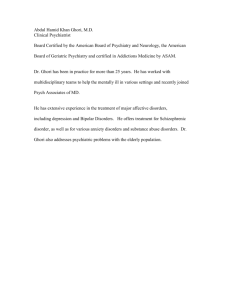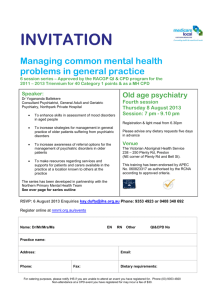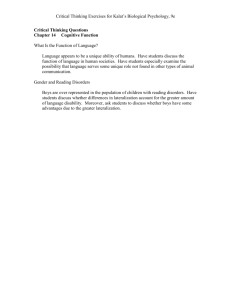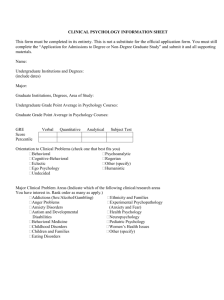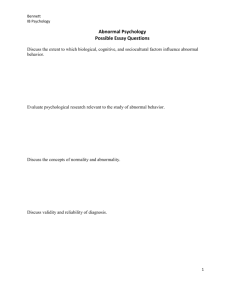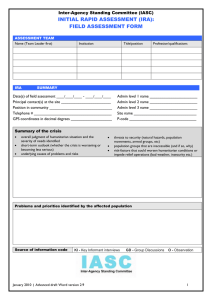abnormal psychology
advertisement
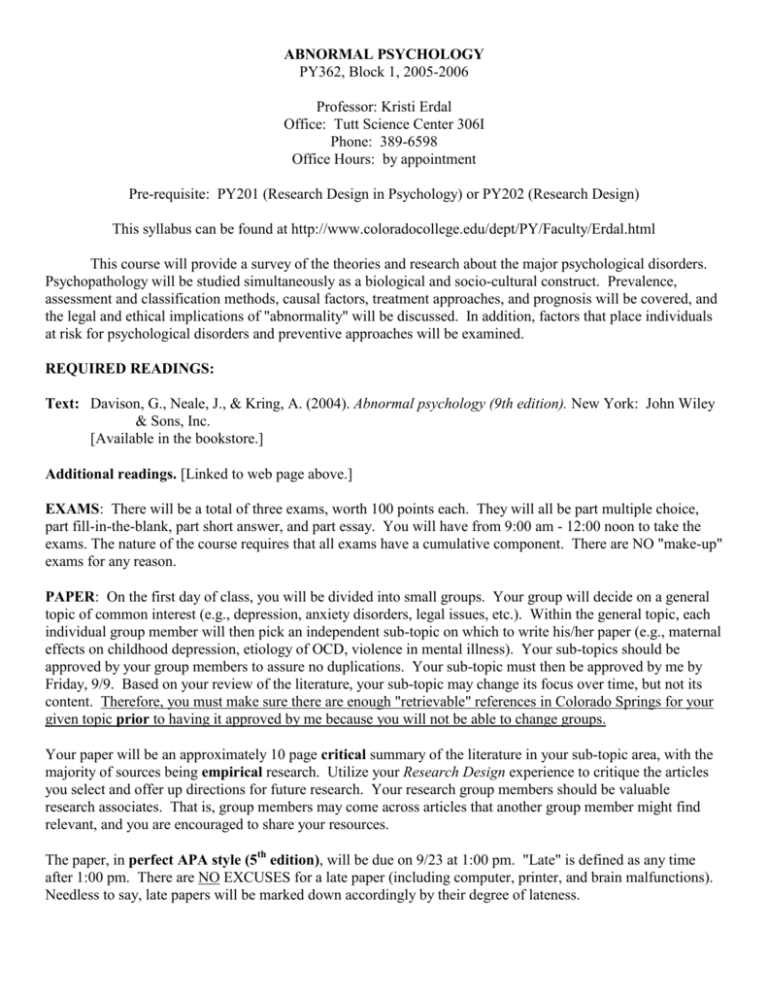
ABNORMAL PSYCHOLOGY PY362, Block 1, 2005-2006 Professor: Kristi Erdal Office: Tutt Science Center 306I Phone: 389-6598 Office Hours: by appointment Pre-requisite: PY201 (Research Design in Psychology) or PY202 (Research Design) This syllabus can be found at http://www.coloradocollege.edu/dept/PY/Faculty/Erdal.html This course will provide a survey of the theories and research about the major psychological disorders. Psychopathology will be studied simultaneously as a biological and socio-cultural construct. Prevalence, assessment and classification methods, causal factors, treatment approaches, and prognosis will be covered, and the legal and ethical implications of "abnormality" will be discussed. In addition, factors that place individuals at risk for psychological disorders and preventive approaches will be examined. REQUIRED READINGS: Text: Davison, G., Neale, J., & Kring, A. (2004). Abnormal psychology (9th edition). New York: John Wiley & Sons, Inc. [Available in the bookstore.] Additional readings. [Linked to web page above.] EXAMS: There will be a total of three exams, worth 100 points each. They will all be part multiple choice, part fill-in-the-blank, part short answer, and part essay. You will have from 9:00 am - 12:00 noon to take the exams. The nature of the course requires that all exams have a cumulative component. There are NO "make-up" exams for any reason. PAPER: On the first day of class, you will be divided into small groups. Your group will decide on a general topic of common interest (e.g., depression, anxiety disorders, legal issues, etc.). Within the general topic, each individual group member will then pick an independent sub-topic on which to write his/her paper (e.g., maternal effects on childhood depression, etiology of OCD, violence in mental illness). Your sub-topics should be approved by your group members to assure no duplications. Your sub-topic must then be approved by me by Friday, 9/9. Based on your review of the literature, your sub-topic may change its focus over time, but not its content. Therefore, you must make sure there are enough "retrievable" references in Colorado Springs for your given topic prior to having it approved by me because you will not be able to change groups. Your paper will be an approximately 10 page critical summary of the literature in your sub-topic area, with the majority of sources being empirical research. Utilize your Research Design experience to critique the articles you select and offer up directions for future research. Your research group members should be valuable research associates. That is, group members may come across articles that another group member might find relevant, and you are encouraged to share your resources. The paper, in perfect APA style (5th edition), will be due on 9/23 at 1:00 pm. "Late" is defined as any time after 1:00 pm. There are NO EXCUSES for a late paper (including computer, printer, and brain malfunctions). Needless to say, late papers will be marked down accordingly by their degree of lateness. GROUP PRESENTATIONS: As a future graduate of a liberal arts institution, it is imperative that you are not only able to write effectively, but that you are also able to communicate what you know orally. As such, during the last week of class, your research group will make an approximately 30 minute presentation to the class on your common topic. You should get together with your group members beforehand to organize your presentation thoughtfully. By presentation, I do not mean reading your paper to the class. I mean briefly (this will be timed) reviewing the topic area, summarizing the research of your sub-topic utilizing visual aids (i.e., transparency, blackboard, powerpoint), briefly discussing the problems and future directions of the research, and then effectively fielding questions. Your group's presentation will serve as the review on that topic for the final exam. Your presentation grade will be based primarily on your contribution to the group presentation. GRADING: Your final grade will be calculated as follows: Exam I Exam II Exam III Paper Presentation = = = = = 20% 20% 20% 20% 20% A AB+ B BC+ C CD+ D NC S 70-100 CR 65-69 93-100 90-92 88-89 83-87 80-82 78-79 73-77 70-72 68-69 65-67 <65 D+, D, CR, or NC would have to be retaken to fulfill Psychology department requirements. A B C D NC Excellent work that reflects superior understanding and insight, creativity, or skill. Good work that reflects a high level of understanding and insight, creativity, or skill. Adequate work that indicates readiness to continue study in the field. Marginal work, only minimally adequate, indicating lack of readiness to continue in the field. Failing work, clearly inadequate and unworthy of credit. COURSE SCHEDULE Date Topic Readings (to be read prior to class) Monday, September 5: 10:30 am Introduction to Course Video: Looking at Abnormal Behavior Assignment to RESEARCH GROUPS Tuesday, September 6: 9:00 am Defining abnormal behavior 1:00 pm Video: Mental Illness: Fact or Myth? DNK, ch. 1 Rosenhan (1973) Szasz (1960) Wednesday, September 7: 9:00 am Psychological perspectives Group Research Topic Due DNK, ch. 2 Freud (1909) Wolpe et al. (1960) Psychological Assessment DNK, ch. 4 Draguns et al. (2003) Manson (1995) 9:00 am Mood Disorders Individual Sub-topics Due Visitor: Esther DNK, ch. 10 Blatt (1995) Antonuccio et al. (1995) 1:30 pm Mood Disorders (continued) Thursday, September 8: 9:00 am Friday, September 9: Monday, September 12: 9:00 am Anxiety Disorders 1:00 pm(?) Meet with RESEARCH GROUPS DNK, ch. 6 Kozaric- et al. (1995) Marks (1997) Tuesday, September 13: 9:00 am Schizophrenia Video: The New Asylums Exam I content ends here. DNK, ch. 11 Shergill et al. (2004) Levin et al. (1996) Wednesday, September 14: 9:00 am – 11:00 am Personality Disorders noon - 5:00 pm Tour of Colorado Mental Health Institute at Pueblo Meet the CC bus behind Tutt Science Center at the Loading Dock DNK, ch. 13 Kiehl et al. (2001) Oldham et al. (1996) Thursday, September 15: 9:00 am Exam I Friday, September 16: 9:00 am Substance Abuse DNK, ch. 12 McCann et al. (1997) MacCoun (1998) 9:00 am Sexual Disorders DNK, ch. 14 McConaghy (1999); pp. 285-302, 306-318 Craissati and Beech (2004) 1:30 pm Visitor: Avy Go over Exam Meet with RESEARCH GROUPS Monday, September 19: Tuesday, September 20: 9:00 am Somatoform & Dissociative Disorders 1:00 pm Video: Mind of a Murderer DNK, ch. 7 Schacter et al. (1996) Krahn et al. (2003) Wednesday, September 21: 9:00 am Exam II Thursday, September 22: 9:00 am Childhood Disorders DNK, pp. 475-482, 506-515 Sacks (1995) Friday, September 23: 9:00 am Aging and psychopathology DNK, ch. 16 Rodin & Langer (1977) 1:00 pm Papers Due / Go over Exam / Group Workshop for Presentations Monday, September 26: 9:00 am GROUP PRESENTATIONS 1:00 pm GROUP PRESENTATIONS (if needed) Tuesday, September 27: 9:00 am Legal and ethical issues Video: My Doctor, My Lover Wednesday, September 28: 9:00 am EXAM III DNK, ch. 18 APA Monitor (1996) Kan (2004) References American Psychological Association Monitor. (1996, Dec.). APA files amicus brief in gay-rights case before Supreme court. Antonuccio, D., Danton, W., & DeNelsky, G. (1995). Psychotherapy versus medication for depression: Challenging the conventional wisdom with data. Professional Psychology: Research and Practice, 26(6), 574-585. Blatt, S. (1995). The destructiveness of perfectionism: Implications for the treatment of depression. American Psychologist, 50(12), 1003-1020. Craissati, J. and Beech, A. (2004). The characteristics of a geographical sample of convicted rapists: Sexual victimization and compliance in comparison to child molesters. Journal of Interpersonal Violence, 19(4), 371-388. Draguns, J. and Tanaka-Matsumi, J. (2003). Assessment of psychopathology across and within cultures: Issues and findings. Behaviour Research and Therapy, 41, 755-776. Freud, S. (1959). The Collected Papers of Sigmund Freud, vol. 3, pp. 243-289. (ed. E. Jones). NY: Basic Books. Kan, D. (2004). Sex offender’s thoughts are protected under the first amendment. The Journal of the American Academy of Psychiatry and the Law, 32(3), 332-333. Kiehl, K., Smith, A., Hare, R., Mendrek, A., Forster, B., Brink, J., & Liddle, P. (2001). Limbic abnormalities in affective processing by criminal psychopaths as revealed by functional magnetic resonance imaging. Biological Psychiatry, 50, 677-684. Kozaric-Kovacic, D., Folnegovic-Smalc, V., Skrinjaric, J., Szajnberg, N., & Marusic, A. (1995). Rape, torture, and traumatization of Bosnian and Croatian women: Psychological sequelae. American Journal of Orthopsychiatry, 65(3), 428-433. Krahn, L., Li, H., & O’Connor, M. (2003). Patients who strive to be ill: Factitious disorder with physical symptoms. American Journal of Psychiatry, 160(6), 1163-1168. Levin, E., Wilson, W., Rose, J., & McEvoy, J. (1996). Nicotine-haloperidol interactions and cognitive performance in schizophrenics. Neuropsychopharmacology, 15(5), 429-436. MacCoun, R. (1998). Toward a psychology of harm reduction. American Psychologist, 53(11), 1199-1208. Manson, S. (1995). Culture and major depression: Current challenges in the diagnosis of mood disorders. Cultural Psychiatry, 18(3), 487-501. Marks, I. (1997). Behavior therapy for obsessive-compulsive disorder: A decade of progress. Canadian Journal of Psychiatry, 42, 1021-1027. McCann, U., Lowe, K., & Ricaurte, G. (1997). Long-lasting effects of recreational drugs of abuse on the central nervous system. The Neuroscientist, 3, 399-411. McConaghy, N. (1999). Unresolved issues in scientific sexology. Archives of Sexual Behavior, 28(4), 285-318. Oldham, J., Skodol, A., Gallaher, P., & Kroll, M. (1996). Relationship of borderline symptoms to histories of abuse and neglect: A pilot study. Psychiatric Quarterly, 67(4), 287-295. Rodin, J. and Langer, E. (1977). Long-term effects of a control-relevant intervention with the institutionalized aged. Journal of Personality and Social Psychology, 35(12), 897-902. Rosenhan, D. (1973). On being sane in insane places. Science, 179, 250-258. Sacks, O. (1995). An anthropologist on Mars (pp. 244-296). In An Anthropologist on Mars: Seven Paradoxical Tales. New York: Alfred A. Knopf. Schacter, D., Koutstaal, W., & Norman, K. (1996). Can cognitive neuroscience illuminate the nature of traumatic childhood memories? Current Opinion in Neurobiology, 6, 207-214. Shergill, S., Brammer, M., Amaro, E., Williams, S., Murray, R., & McGuire, P. (2004). Temporal course of auditory hallucinations. British Journal of Psychiatry, 185, 516-517. Szasz, T. (1960). The myth of mental illness. American Psychologist, 15, 113-118. Wolpe, J. and Rachman, S. (1960). Psychoanalytic "evidence": A critique based on Freud's case of Little Hans. Journal of Nervous and Mental Disease, 130, 135-148.
